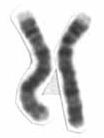Chromosome 4 is one of the 23 pairs of chromosomes in humans. People normally have two copies of this chromosome. Chromosome 4 spans more than 186 million base pairs (the building material of DNA) and represents between 6 and 6.5 percent of the total DNA in cells.
Identifying genes on each chromosome is an active area of genetic research. Because researchers use different approaches to genome annotation their predictions of the number of genes on each chromosome varies. In January 2017, two estimates differed by 12%, with one estimate giving 2,441 genes, and the other estimate giving 2,164 genes.
The chromosome is ~191 megabases in length. In a 2012 paper, seven hundred and fifty seven protein encoding genes were identified on this chromosome. Two-hundred and eleven (27.9%) of these coding sequences did not have any experimental evidence at the protein level, in 2012. Two-hundred and seventy one appear to be membrane proteins. Fifty-four have been classified as cancer associated proteins.
The following are some of the genes located on chromosome 4:
ANK2: ankyrin 2, neuronal
ACVR1: activin-like kinase 2 (ALK-2)
ACOX3: encoding enzyme Peroxisomal acyl-coenzyme A oxidase 3
AGPAT9: encoding enzyme Glycerol-3-phosphate acyltransferase 3 a.k.a. 1-acylglycerol-3-phosphate O-acyltransferase 9
APBB2: encoding protein Amyloid beta A4 precursor protein-binding family B member 2
ART3: encoding enzyme Ecto-ADP-ribosyltransferase 3
ASAHL: encoding enzyme N-acylethanolamine-hydrolyzing acid amidase
C4orf18: encoding protein Protein ENED
Complement Factor I: Complement Factor I
CRMP1: Collapsin response mediator protein 1, a member of CRMP family
CXCL1: chemokine (C-X-C motif) ligand 1, scyb1
CXCL2: chemokine (C-X-C motif) ligand 2, scyb2
CXCL3: chemokine (C-X-C motif) ligand 3, scyb3
CXCL4: chemokine (C-X-C motif) ligand 4, Platelet factor-4, PF-4, scyb4
CXCL5: chemokine (C-X-C motif) ligand 5, scyb5
CXCL6: chemokine (C-X-C motif) ligand 6, scyb6
CXCL7: chemokine (C-X-C motif) ligand 7, PPBP, scyb7
CXCL8: chemokine (C-X-C motif) ligand 8, interleukin 8 (IL-8), scyb8
CXCL9: chemokine (C-X-C motif) ligand 9, scyb9
CXCL10: chemokine (C-X-C motif) ligand 10, scyb10
CXCL11: chemokine (C-X-C motif) ligand 11, scyb11
CXCL13: chemokine (C-X-C motif) ligand 13, scyb13
DUX4: Thought to be inactive but 2010 research shows a key role in FSHD
EVC: Ellis van Creveld syndrome
EVC2: Ellis van Creveld syndrome 2 (limbin)
Factor XI: Mutations cause Haemophilia C
FGF2: Fibroblast growth factor 2 (basic fibroblast growth factor)
FGFR3: fibroblast growth factor receptor 3 (achondroplasia, thanatophoric dwarfism, bladder cancer)
FGFRL1: fibroblast growth factor receptor-like 1
HCL2 (also called RHA or RHC): related to red hair
HTT (Huntingtin): huntingtin protein (Huntington's disease)
IGJ: linker protein for immunoglobulin alpha and mu polypeptides
KDR: Kinase insert domain receptor (Vascular endothelial growth factor receptor 2)
MMAA: methylmalonic aciduria (cobalamin deficiency) cblA type
PHOX2B: codes for a homeodomain transcription factor
PKD2: polycystic kidney disease 2 (autosomal dominant)
PLK4: Serine/threonine-protein kinase PLK4
QDPR: quinoid dihydropteridine reductase
STATH: gene with protein product
SNCA: synuclein, alpha (non A4 component of amyloid precursor)
UCHL1: ubiquitin carboxyl-terminal esterase L1 (ubiquitin thiolesterase)
UNC5C: netrin receptor UNC5C
WFS1: Wolfram syndrome 1 (wolframin)
Diseases and disorders
The following are some of the diseases related to genes located on chromosome 4:
Achondroplasia
Autosomal dominant polycystic kidney disease (PKD-2)
Bladder cancer
Crouzonodermoskeletal syndrome
Chronic lymphocytic leukemia
Congenital central hypoventilation syndrome
Ellis-van Creveld syndrome
Facioscapulohumeral muscular dystrophy
Fibrodysplasia ossificans progressiva (FOP)
Haemophilia C
Huntington's disease
Hemolytic uremic syndrome
Hereditary benign intraepithelial dyskeratosis
Hirschprung's disease
Hypochondroplasia
Methylmalonic acidemia
Muenke syndrome
Nonsyndromic deafness
Nonsyndromic deafness, autosomal dominant
Parkinson's disease
Polycystic kidney disease
Romano-Ward syndrome
SADDAN
Tetrahydrobiopterin deficiency
Thanatophoric dysplasia
Type 1
Type 2
Wolfram syndrome
Wolf–Hirschhorn syndrome

